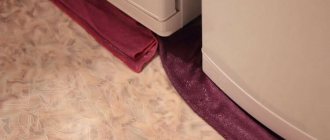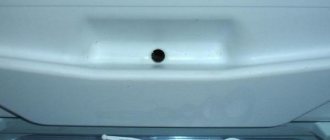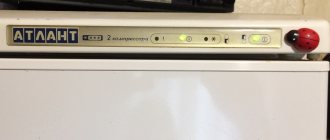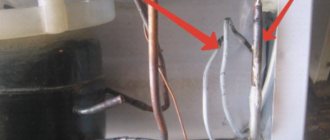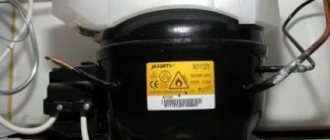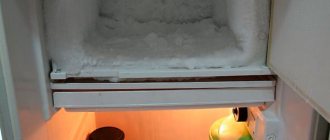A refrigerator is an expensive but necessary kitchen appliance that allows you to keep food fresh. And any malfunction of this device becomes a real problem for the owners. The most common sign of a refrigerator malfunction is water accumulation.
Water in the refrigerator is a symptom that should not be ignored. It indicates malfunctions that lead to incorrect operation of the device and an increase in temperature in the chamber, which can lead to premature spoilage of food. In addition, water seeps through cracks into the most important components of the device, leading to wear and corrosion. In the end, such a unit will simply fail.
Why water appears in the refrigerator and how to deal with it - read on.
Determining the type of refrigerator
Before you begin to find out the reason for the appearance of water in the refrigerator, it is worth deciding on the type of device. In modern units, refrigeration chambers are of two types.
Drip system
This system is also called a “crying back wall”. The cold compartment evaporator is located behind the rear wall of the drip unit. When the temperature drops, the back wall of the device becomes covered with frost, and when the indicators reach the specified parameters, the cooling stops.
The rear wall evaporator begins to heat up until its temperature is equal to that of the refrigerator compartment. This leads to the formation of water droplets on the back wall. The liquid flows into the drain hole, from where a special reservoir is directed. There it evaporates.
No Frost
There is no separate evaporator in the refrigerator compartment. Its function is performed by an evaporator located in the freezer. Above it is a fan that moves cool air through the evaporator into the freezer and refrigerator compartments. Moreover, less air enters the refrigerating chamber, which is regulated by a special damper. Therefore, frost does not form at all in the refrigerating chambers of No Frost appliances.
If you have a refrigerator with a drip system and water appears
Now I will tell you what reasons lead to the accumulation of water in units with this type of thawing. Some problems can be fixed on your own, but some will require a professional approach.
Drain clogged
In 99% of cases, the cause is a clogged drain hole or hose - it is simply clogged . The direct purpose of this unit is violated - the removal of condensate from the refrigeration compartment into a special container. The liquid, not finding a way out, flows by gravity under the boxes for fruits and vegetables.
Such phenomena are due to the characteristics of the system itself. The water drain may contain food debris, dust, and crumbs (again, a matter of care!). In addition to puddles, a characteristic unpleasant odor appears inside the chamber. During the cooling cycle, liquid stagnant in the hole freezes. Gradually, ice forms on the back wall.
If you ignore this point, the compartment will gradually lose cooling capacity . Freezing of the evaporator will cause continuous operation of the motor. The compressor will turn on more often to compensate for the lack of cold.
Solution: it is necessary to clean the drain, which will restore the normal functionality of the unit. This operation can be performed on your own.
Refrigerator care
First stage:
- To begin with, the refrigerator is de-energized; in other words, the plug is removed from the socket. For cleaning, take a syringe and a simple cotton swab;
- boxes for fruits and vegetables are removed from the compartment;
- If ice has not yet formed around the hole, carefully clean it with a stick. You can use the accessory that the manufacturer included in the kit;
- At the end, you should rinse the drain using a syringe with warm water.
If cleaning is successful, water will begin to flow into the drain tank. If the fluid does not pass through, this indicates that the drainage hose is frozen.
Here you need the second method:
- the unit is completely defrosted, after which the first method is duplicated. Defrosting must be of high quality, at least 12 hours;
- the channel is cleared with wire if liquid still enters the compartment. All actions must be careful, otherwise the drainage hose may be damaged. If this technique does not help, feel free to call a specialist.
Sometimes liquid from a weeping evaporator accumulates at the bottom of the chamber if products come into contact with it . It makes sense to check this point as well. In another case, the tray into which water flows from the evaporator may become deformed or move. To correct the problem, the part is replaced or reinstalled.
If you want to carry out the process yourself, the user manual contains information about where exactly the liquid collection tray is located . To replace it, you need to remove the bottom panel or front cover (depending on the model). If the item is intact, it is simply put back in its place. If a breakdown occurs, you can purchase a new tray and install it in place.
Incorrect installation
In an unevenly installed refrigerator, the door does not fit tightly. A whole tangle of problems arises here . Warm air in the chamber provokes continuous operation of the compressor, which leads to its rapid wear and breakdown of other components. Plus, high motor activity causes the drainage hole to freeze, which causes water to accumulate. The condensate collection tank can also be overfilled, so puddles appear not only in the compartment, but also under the refrigerator.
Solution to the problem: the unit must be positioned strictly horizontally. It is necessary to tighten the legs and check that the installation is level.
Tips for placing appliances in the kitchen
Poor seal seal
If the rubber in the unit is damaged or worn out, this also provokes the entry of warm air inside . This situation is similar to the previous one: the motor starts working three times more often than usual, the drainage freezes, and water appears. The solution to the problem is to replace the sealing rubber.
The problem of a loose seal
In order to install a new seal, you need to remove the door. Old rubber is removed in different ways, depending on the type of its fixation). For example, self-tapping screws are unscrewed and the foam is removed with a knife. After dismantling, a new seal is installed and the door is put in place .
Thermal sensor failure
A broken temperature sensor can cause the compressor to work more often than necessary. Water accumulation occurs according to a familiar pattern: freezing of the rear wall and drainage tube. When the unit is turned off, the ice begins to melt, which forms a lot of water, and with the blockage it flows onto the lower wall. I note that temperature sensors are rarely repairable; the unit will have to be replaced with a new one.
If the refrigerator does not turn off...
Reasons for water accumulation in devices with a drip system and repair methods
It is the owners of equipment with a drip system who are more often faced with the problem of water appearing in the refrigeration chamber. Indeed, in this case the evaporator is located directly in the refrigerating chamber.
There are several reasons why this problem occurs.
Clogged hole and steam pipe
Often the answer to the question of why water accumulates in the refrigerator under the vegetable drawers is a clogged drain (drain hole and drain). It is through it that the water accumulating on the wall is discharged into a special tank.
If the drainage is clogged, the liquid stagnates in the drainage, and its excess flows to the bottom of the refrigerator compartment, under the vegetable boxes. Often this problem is accompanied by an unpleasant odor.
Such a breakdown is dangerous because if the drain hole is clogged for a long time, the evaporator does not have time to thaw and becomes covered with an ice crust. This leads to a steady increase in the temperature in the chamber and a decrease in the frequency of compressor shutdowns. Consequently, food begins to spoil faster and more electricity is wasted.
You can cope with the problem at home. Two methods are used to remove blockages.
How to clear a blockage using a cotton swab and a syringe:
- The refrigerator is disconnected from the power supply. All products are removed from the freezer and refrigerator compartments.
- Use a cotton swab to clean the drain hole.
- Using a syringe, pour water into the cleaned hole. If the liquid disappears, it means the procedure was successful.
If after this procedure the water in the refrigerator still does not drain into the hole, then the reason lies either in a deeper blockage or in the freezing of the drainage hose. In this case, use the second cleaning method:
- The refrigerator is disconnected from the power supply, the food is removed from it and wait until it is completely defrosted.
- The drain is cleaned using a cotton swab or other similar product in the manner described above. The hole is washed with a syringe.
- The end of a thin but strong wire is bent. The resulting device is carefully inserted into the drain, removing the accumulated debris. A similar procedure is performed at the other end of the hose.
- After cleaning, water is again poured into the drain using a syringe to clear the hole of any remaining debris and make sure the repair is successful.
If the methods described above did not help, and the drain remains clogged, then you cannot do without the help of a specialist.
Note! Often the refrigerator comes with a drain cleaning tool.
Incorrect installation
Water appears under the fruit and vegetable drawers if the door does not seal completely. One of the reasons for this problem is considered to be incorrect installation of the device.
If the refrigerator is not level, the door will not fit tightly and will remain slightly open. Warm air will flow into the chamber, causing the compressor to turn off less frequently to compensate for the rise in temperature. This will cause ice to form on the drain hole and the back of the appliance.
Important! If the door is installed incorrectly and the door does not fit tightly, the device consumes more electricity.
To correct the situation, you will have to disconnect the unit from the power supply and completely defrost it, after removing the food. Then it is set according to level. Some models have a height adjustment option.
Seal damage
If you still haven’t been able to figure out why water is forming in the refrigerator, you should assume that there are more serious breakdowns . One of them is wear of the seal.
The seal is attached to the body of the device and to the door, ensuring a tight fit of the latter. Thanks to this, the chamber is always hermetically sealed.
If the seal does not fit tightly to the base, the seal is broken, and warm air constantly enters the refrigerator compartment. To compensate for the increase in temperature, the capacitor begins to work, practically without turning off. This leads to accelerated wear of parts, freezing of the drain and rear wall, and increased energy consumption.
A number of signs indicate wear or damage to the seal. These include:
- the compressor turns off less frequently than usual;
- food, especially near the back wall, often freezes;
- a thick ice crust appears on the back wall and near the drainage hole.
If the seal is damaged, the situation will only be corrected by replacing it. Doing this on your own is problematic. Therefore, it is better to contact a specialist.
Temperature sensor malfunction
The temperature sensor is responsible for regulating the temperature in the refrigerator compartment. It is thanks to this that the compressor turns off when the temperature drops to the desired level and turns on when it rises.
Failure of this element results in the compressor switching off too rarely or too often. For this reason, the wall and drain of the device are covered with ice, and water accumulates at the bottom of the chamber.
Doing anything in this case yourself is not recommended. Repairs should be entrusted to a specialist.
Why does water accumulate in the refrigerator?
When faced with an accumulation of water in the refrigerator, wiping the wet area with a dry cloth will not be enough. Therefore, we will consider common and other possible causes, as well as ways to eliminate them.
First of all, you should determine what cooling technology is used in your refrigerator. Modern Atlant refrigerators most often use two main technologies: with drip defrosting or with an automatic defrosting system - “NoFrost”.
The operating principle of a refrigerator with a drip defrost system. The evaporator of the refrigerator compartment is located behind the rear wall of the chamber. During the cooling process, the evaporator and the rear wall of the chamber become covered with ice (frost). Having reached the set temperature in the refrigerator compartment, cooling stops. The ice begins to melt, and condensation appears in the form of water droplets on the back wall of the refrigerator compartment. After which all the moisture flows down the hose into a special container, where it subsequently completely evaporates. This container is installed near the compressor.
Refrigerator device with automatic defrosting system NoFrost.
The cooling process is realized by the evaporator of the freezer compartment and a fan. The air circulates in two compartments thanks to a fan and passes through the evaporator. As a result, cooling occurs. Most of the cold air goes into the freezer, and less into the refrigerator. When the set temperature is reached, the sensor closes the damper, thereby stopping the cooling of the air. Otherwise, it's the other way around. When the temperature in the chamber rises, the sensor opens the damper and starts the cooling process.
Using these systems as an example, we will analyze cases of possible defects that are directly related to each cooling system.
Possible causes of water accumulation in a refrigerator with a drip defrosting system
— Clogged hose or drain.
The most common cause of water accumulation. In this case, drops of water flowing into a special hole/tube will not be able to enter a special container for further evaporation. This is why water accumulates on the lower shelves.
The solution is to clean the tube and condensate drain hole.
- It is necessary to turn off the power to the refrigerator and clear the bottom shelf for easier access to the hole.
- Then, using a special device provided by the manufacturer for such work, clean it.
- All that remains is to rinse the drain with a syringe filled with warm water. If successful, water should flow freely into a special container.
If all these steps do not help, you need to completely defrost the refrigerator and clean the drain system with wire or any thin and elastic object. The main thing is to do this carefully so as not to damage the drain hose and other elements of the system.
— A loose door.
For this reason, warm air enters the refrigerating chamber in large quantities, thereby forcing the compressor to work without stopping. Because of this, the drainage hole freezes and does not allow accumulated water to escape.
To solve this problem, you need to place the refrigerator horizontally and make sure it is stable on the surface.
— Defective seal or lack of a tight fit.
In this situation, the seal needs to be replaced.
— Failure of the temperature sensor.
To find a solution, contact a service center for diagnosis and repair.
Possible reasons for water accumulation in a refrigerator with an automatic defrosting system “NoFrost”
In the case of refrigerators with such a defrosting system, you must immediately seek professional help from a service center. Since when water appears in the refrigerator compartment, it indicates the presence of serious problems. If one working unit fails, others may also be damaged.
In conclusion, we can say that if problems arise with the refrigerator, it is important to determine which defrosting system it uses. And based on this, it is clear whether you are able to figure out the problem yourself or whether it is better to contact a service center for help.
Reasons for water accumulation in No Frost refrigerators
No Frost refrigerators are designed differently. Frost does not form on their back wall and water droplets do not collect.
If liquid accumulates at the bottom of the device, then you cannot do without the help of a specialist. Most often, the problem lies in a breakdown in the defrost module.
Such malfunctions are accompanied by a number of symptoms. These include:
- the refrigerator works without interruption;
- the temperature in the refrigerator compartment is increased;
- the walls of the freezer are covered with a thick ice crust;
- Liquid collects at the bottom of the device.
Malfunctions of various parts can cause malfunctions in the defrost module, but more often they become unusable:
- defrost sensor;
- timer;
- Evaporator heating element;
- fuse.
With such a breakdown, the freezer does not thaw. It is covered with a thick ice crust. The air supply valve to the refrigerator compartment is also covered with ice, as a result of which the latter does not cool. Due to the temperature difference, the ice in the air duct melts and water flows into the refrigerator.
It is impossible to fix such a malfunction on your own - you need the help of a specialist.
Less often, the reason lies in a clogged drain. This malfunction can be repaired independently. To do this, the unit is disconnected from the power supply and defrosted. The drain hole in the freezer is cleaned:
- Use an ear stick to remove or push through the blockage.
- Use a syringe to rinse the drain, checking the permeability of the liquid.
- If after cleaning the water from the syringe does not pass through the drain, the blockage is broken through with wire from both sides. The patency of the drain is checked again with a syringe.
The most common types of breakdowns
A refrigerator is a complex household device in which air is cooled through air circulation, during which condensation is formed. Part of it remains in the freezer compartment, accumulating in the form of ice, the rest flows into a special tray. When there is too much ice, the refrigerator needs to be defrosted to clear it of ice.
Modern devices with a dry freezing and no frost system, for example, from Atlant, Samsung or other well-known manufacturers, do not allow the formation of an ice mass, since the condensate quickly evaporates, so they do not require defrosting. However, if there is a malfunction, the condensate either remains completely in the freezer, freezing on the walls, or begins to flow inside the device onto the bottom shelf.
Most often, if the refrigerator is leaking inside, the reasons that caused this malfunction are corrected in a matter of minutes on their own. And only in some cases the intervention of specialists is necessary.
Drain hole clogged
First of all, you need to check whether the drainage hole is clogged. To eliminate condensation that occurs inside, the refrigerator has a special hole through which liquid flows into the tray. Food particles can easily get in here and easily clog it. In this case, the following symptoms will be observed:
- the water is located mainly on the bottom shelf, in some cases on the floor;
- There is a large layer of ice in the refrigerator compartment.
You can deal with the problem using a 20 ml syringe or a rubber syringe and hot water. You need to squeeze water out of the syringe into the drainage hole once or twice; under the pressure of water, the blockage is removed. You can also remove the valve from the bottom of the device and clean it by hand.
Violations of operating rules and water in the refrigerator
Sometimes problems in the refrigerator are not associated with any breakdowns, but are a consequence of violation of operating rules or exposure to external factors.
Let's look at where the water at the bottom of the refrigerator compartment might come from:
- Warm or hot foods are placed in the refrigerator. This leads to an increase in temperature in the device and increased compressor operation. The wall and drain are covered with ice and water accumulates in the vegetable boxes. If such a violation is committed systematically, this leads to wear of parts.
- Sometimes the problem lies not in the refrigerator itself, but in the socket or wiring. This also applies to a plug that is not fully inserted into the socket. Systems with electronic modules break down due to voltage surges.
- If one of the household members constantly leaves the refrigerator door ajar, this will also lead to leaks and all other consequences.
- When you return from a trip and find water in the refrigerator, you should not panic ahead of time. It is quite possible that the lights were turned off in the house during the owner’s absence. This led to the freezing of equipment.
- Many refrigerators have a button that can be used to turn off and restore the power. It is quite possible that the appearance of liquid in the chambers and the increase in temperature are caused by carelessly pressing this button.
- In a drip system, it is not recommended to place products close to the evaporator. This often causes liquid to appear under the drawers.
Reasons for condensation in the refrigerator
If you have decided on the defrosting system, then you can start looking for the problem.
For drip-type refrigeration equipment
As already mentioned, condensation on the back wall of the refrigerator is normal. But if accumulations of water are observed in other places, you need to check the drainage system for blockages.
- The drainage chamber or tube is clogged. There is nowhere for moisture to drain from the wall, so it accumulates below. The causes of blockage are small crumbs and debris that fall with drops of water. As a result, the evaporator does not have time to thaw and becomes covered with snow. A cotton swab or other thin object will help remove the blockage. You can also use a syringe. Pour warm water into the drain compartment until it is flushed.
- Depressurization. Worn door rubber does not allow the chamber to be sealed. Warm air penetrates the compartment, and the refrigerator, compensating for the increase in temperature, works even harder. Then the seal needs to be urgently replaced. The door may not close properly due to improper installation of the equipment. If the body is tilted forward, the door opens randomly.
- Malfunction of the temperature sensor, which notifies the system about the temperature in the chamber. Incorrect operation leads to a decrease in the temperature in the chamber, the walls become covered with snow.
You can fix most problems yourself. But some need professional repairs.
Water in the freezer
Water cannot appear in liquid form in the freezer. But often a thick ice crust forms at the bottom of this part of the refrigerator. This problem occurs for the following reasons:
- Clogged drain hole. To solve the problem, turn off the refrigerator and wait until the freezer freezes. Then use a wire or cotton swab to clean the drainage. The success of the procedure is checked by pouring water from a syringe into the hole.
- Breakdown in the defrost system. In addition to the ice crust, the freezer will rarely turn off the compressor. In No Frost devices, the refrigerator compartment will also cool worse; liquid will collect at its bottom. Electronic equipment will display error information on the screen and emit a characteristic squeak. It is impossible to repair the defrost module on your own; you will need to call a specialist.
If a breakdown occurs in the freezer compartment of an appliance with a No Frost system, then the refrigeration compartment will also not work properly. Equipment with a drip system does not have such a disadvantage, since its compartments operate separately from each other.
Such breakdowns lead not only to a deterioration in the cooling performance of the device, but also to an increase in electricity consumption.
Note ! If water collects under the refrigerator, the water collection tank is damaged. The problem can be solved by replacing this part or gluing the cracks with waterproof compounds.
Drip defrost system: we eliminate the cause of water in the refrigerator compartment ourselves
1. Drain hose or hole is clogged. If water regularly accumulates in a refrigerator with a “crying” evaporator underneath the fruit and vegetable drawer, then most likely the drainage is clogged. Its purpose is to remove melt water from the refrigeration compartment into a special tank located near the compressor. Drain blockages occur due to the characteristics of the drip defrost system: dust, crumbs, food residues, etc. can get into the drainage hole along with drops of melt water (which can cause an unpleasant odor in the refrigerator). When the drain is clogged, the water cannot escape. It stands in the drainage, and the excess flows to the bottom of the refrigerator, just under the drawers. During the cooling cycle, the water in the drain often freezes and ice forms in and around the drain hole. Ignoring a clogged drain hole for a long time can lead to freezing of the refrigerator compartment evaporator (it will not have time to thaw) and loss of cooling capacity. At the same time, the refrigerator compressor will turn off less often to compensate for the lack of cold.
In order to restore normal operation of the refrigerator, you should clean the drain hole.
Below are two possible cleaning schemes that should be applied sequentially. Scheme No. 1. Cotton swab + syringe
- Unplug the refrigerator. Before starting work, unplug the refrigerator and remove the fruit and vegetable drawers from it.
- Clean the drain hole. If there is no ice around the drainage hole, try clearing it with a cotton swab or similar non-sharp object. Many models include a special device designed for this purpose.
- Flush the drain. Take a small syringe with warm (not hot!) water and squirt water into the drain hole several times. If the water successfully drains into the condensate collection tray, congratulations, the blockage has been eliminated.
If these actions do not bring the desired result, and all the water from the syringe pours back into the refrigerator, most likely the drainage hose is frozen, and you cannot do without completely defrosting the refrigerator.
Scheme No. 2. Defrost the refrigerator and, if necessary, use wire
- Defrost the refrigerator and repeat cleaning and syringing the drain. To do this, remove food from the refrigerator and leave it turned off with the door open for 8-12 hours. After defrosting, repeat the procedure of cleaning and syringing the drain.
- Clean the drain channel using a wire. If water still does not flow into the condensate pan, take a thin wire and use it to clear the drain. In this case, you need to act as carefully as possible so as not to damage the drainage hose and the plastic of the refrigerator. Moreover, you should try to clean it with a wire both from the side of the drainage hole from inside the refrigerator and from the opposite end of the drainage hose. As a rule, this method allows you to achieve a positive result. Otherwise, call a professional refrigerator repair technician.
2. Incorrect installation of the refrigerator. If the refrigerator is not installed level, the door may not fit tightly. Because of this, warm air will enter the refrigerator compartment, and the unit, trying to compensate for the lack of cold, will turn off less often. Infrequent outages can cause ice to form on the back wall of the refrigerator compartment and around the drainage hole until it completely freezes. During rare defrost cycles, the drain hole will not be able to cope with the increased amount of water (or the moisture will not drain at all if the drain is frozen), and water will collect in the refrigerator compartment below the drawers. In addition, the water collection tank may also not be able to handle the amount of water, and then you will see a puddle under the refrigerator. To fix the problem, you need to install the refrigerator strictly at level.
If cleaning the drainage hole and adjusting the level did not bring results, and water still accumulates in the refrigerator under the drawers, most likely there is a breakdown, the elimination of which will require the intervention of a professional technician.
